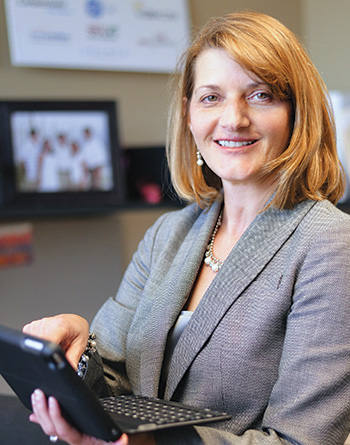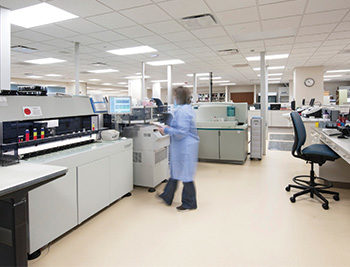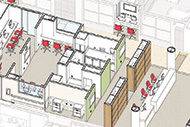 |
|
PHOTO BY DANA THOMAS Debbie Gregory |
Creating efficient, safe clinical spaces requires accommodating new technology, the human touch that promotes patient healing and staff interaction as nurse and design consultant Debbie Gregory explains.
In designing clinical spaces today, what are some of the keys to improving patient safety and outcomes while optimizing workflow? What is your role in helping to achieve these objectives?
One of the most important keys to improving quality and safety in health care today is interprofessional collaboration. Input from the clinical, biomedical, pharmacy, infection control, information technology, environmental services and other disciplines is vital to achieve optimal healing environments.
With an interprofessional focus on the patient, the care delivery process can be examined and re-engineered to optimize workflow, quality and safety. In my role, I often serve as a bridge to connect the right people and ask the right questions. As a nurse and interior designer, I understand the important connection between design and function, especially in the clinical space.
I often feel like a health care symphony conductor in the coordination of each component to bring about excellent care delivery. Today, the focus is moving from the health care incident to the health care continuum, and clinical design is changing accordingly.
How is the growing array of technologies affecting designers of clinical spaces?
The explosion of technology has created significant challenges for architects and designers, with specific regard to integration with infrastructure, space planning and strategic management. The most effective approach to managing these challenges is to create a strategic technology master plan that aligns with the vision and mission of the health system.
This plan should include:
• Creating a technology governance committee to guide and operationalize the program.
• Developing a manageable clinical communication strategy that encompasses nurse call, mobile devices and alarm management.
• Consolidating and streamlining devices.
• Reviewing current technology investments to determine optimization or duplication. Service contract review is important as well.
In our practice at Smith Seckman Reid, we conduct post-occupancy evaluations on projects that have been in operation for one year. We take the results of those evaluations to continually shape best practices and apply them to other projects.
What are the steps to accommodating the increasing presence of technology in patient rooms and the OR?
Staying a step ahead of the technology curve is a challenge, especially when technology itself is so far ahead of practice transformation. The key to accommodating technology in the patient room and the operating room is creating an integration strategy.
Developing a plan for interoperability and integration is imperative for successful clinical workflow and documentation, particularly in a time when the real estate of the headwall is at such a premium.
Unfortunately, vendors are not held to an interoperability standard. It is important to identify the platform for interoperability and align with vendors that are interested in becoming partners in the care delivery process.
Many of our post-occupancy evaluations reveal technologies that were purchased but not maximized, and using technology just for technology’s sake is a costly mistake. Technology in the OR is more about the physician and nurse workflow, so including doctors and nurses in the planning and design conversation is a smart investment.
How do you ensure an adequate level of clinical representation in the design process? Why is clinical representation important?
I strongly recommend creating a position on the owner side dedicated to the project that represents the clinical voice. This person will have the knowledge and understanding of the health system culture and mission and can be a continuous thread throughout the project.
Also, she or he will be an effective advocate for the clinical perspective and be able to educate staff related to the architectural perspective. The Nursing Institute for Healthcare Design is a great resource for nurses in this position.
The ongoing historical knowledge throughout the project, documentation of design decisions and internal communication are key. This is a new role in the nursing industry, and its emergence successfully has shaped countless design projects toward creating a more patient- and staff-centered approach.
What types of technological changes do you foresee having an impact on clinical design in the near future?
The smartphone — with its ability for text messaging, nurse call and alarm notification — already is making dramatic changes in clinical efficiency and communication. Telemedicine and wearable technology are transforming the way health care is delivered, and these areas will continue to grow.
With my crystal ball, I see a caregiver watch that allows nurses to communicate and chart, and a patient gown that can capture vital signs and other data.
Nurses are very social and enjoy a supportive environment, and there are downsides to the modern decentralized environment. Many nurses feel isolated at work and are experiencing a decreased level of mentoring. Technology can enhance communication but cannot substitute for mentoring or lending a helping hand, so considering new technology must always include an eye on the human element.
How can health care facilities prepare for continuous technology changes?
I cannot stress enough the importance of allocating within the budget the time and resources for education. With a technology master plan in place, driven by a technology steering committee, the operationalizing of the technology needs a strategic plan in place as well.
When deploying several technologies at one time, many staff feel as though they are drinking from a fire hose. Initial classes, follow-up classes, reminders, educational videos, best practice discussions, and re-evaluations are all part of successful technology deployment and critical to keeping staff members from falling back into old processes and habits, which will most assuredly happen without continuous education.
There is an emphasis on evidence- based design in patient rooms in new and renovated hospitals. How do you achieve a balance between so-called healing design and accommodating essential technology?
Essential technology isn’t necessarily contrary to healing design. What if research shows that patients who have access to friends and family on Facebook or Facetime have improved outcomes? Not many people age 18 to 30 today would want to be hospitalized without their mobile phone or connection with the world.
As a nurse at heart, I must emphasize that there are no substitutes for the healing touch, caring and empathy. These attributes cannot be built in an environment nor embedded in technology — and yet, there’s no doubt that technology will continue to play an ever-greater role in health care. As technology evolves, we also must evolve to ensure that the focus remains on the human healing interaction. HFM
Jeff Ferenc is senior editor of Health Facilities Management.
The Gregory file
CV
• Senior clinical consultant, technology group, Smith Seckman Reid Inc.
• Co-founder and past president, Nursing Institute for Healthcare Design
• Served as a nurse at the VA Medical Center and Vanderbilt Medical Center, both in Nashville
Accomplishments
• Received Healthcare Hero Award from the Nashville Business Journal
• One of five designers featured in the article “Hybrid Professionals” published in Perspective, the magazine of the International Interior Design Association.
Education
• Vanderbilt University School of Nursing, bachelor of science in nursing
• Watkins College of Art and Design, degree in interior design
• University of Minnesota School of Nursing, doctorate of nursing practice — health innovation and leadership (will complete May 2016)





